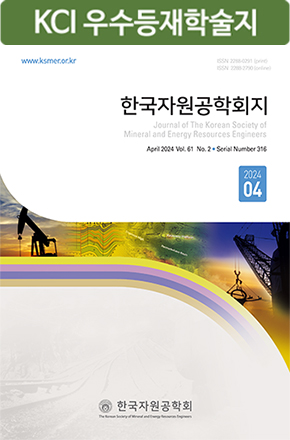Research Paper
- Bland, W. and Rolls, D., 1998, Weathering: An Introduction to the Scientific Principles, Arnold, London, UK, pp. 87-92.
- Carlson, W.D., 2006. “Three-dimensional imaging of earth and planetary materials,” Earth and Planetary Science Letters, Vol. 249, pp. 133-147.
- Chen, T.C., Yeung, M.R. and Mori, N., 2004, “Effect of water saturation on deterioration of welded tuff due to freeze-thaw action,” Cold Regions Science and Technology, Vol. 38, pp. 127-136.
- Cho, T.C., Lee, S.B., Hwang, T.J. and Won, K.S., 2009, “Variations of Mechanical Properties of Hallasan Trachyte with respect to the Degree of Weathering,” Tunnel and Underground Space, Vol. 19, No. 4, pp. 287-303.
- Davis, N., 2001, Permafrost: A Guide to Frozen Ground in Transition, University of Alaska Press, Fairbanks, USA, p.351.
- Davidson, G.P. and Nye, J.F., 1985. “A photoelastic study of ice pressure in rock cracks,” Cold Regions Science and Technology, Vol. 11, pp. 141-153.
- Dewanckele, J., Van Loo, D., Vlassenbroeck, J., Boone, M.N., Cnudde, V., Boone, M.A., De Kock, T., Van Hoorebeke, L. and Jacobs, P., 2010, “Contributions of X-ray CT to the characterization of natural building stones and their disintegration,” Proceeding of the international workshop on X-ray CT for geomaterials, GeoX 2010, New Orleans, Louisiana, USA, February 28-March 3, pp. 164-171.
- Fujun, N., Guodong, C., Huimin, X. and Lifeng, M., 2006, “Field experiment study on effects of duct-ventilated railway embarkment on protecting the underlying permafrost,” Cold Regions Science and Technology, Vol. 45, pp. 178-192.
- Gautier, D.L., Bird, K.J., Charpentier, R.R., Grantz, A., Houseknecht, D.W., Klett, T.R., Moore, T.E., Pitman, J.K., Schenk, C.J., Schuenemeyer, J.H., Sørensen, K., Tennyson, M.E., Valin, Z.C. and Wandrey, C.J., 2009. “Assessment of undiscovered oil and gas in the Arctic,” Science, Vol. 324, pp. 1175-1179.
- Grossi, C.M., Brimblecombe, P. and Harris, I., 2007, “Predicting long term freeze-thaw risks on Europe built heritage and archaeological sites in a changing climate,” Science of the Total Environment, Vol. 377, pp. 273-281.
- Hall, K., 1999, “The role of thermal stress fatigue in the breakdown of rock in cold regions,” Geomorphology, Vol. 31, pp. 47-63.
- Hall, K., Cullis, A. and Morewood, C., 1989, “Antarctic rock weathering simulations: simulator design, application and use,” Antarctic Science, Vol. 1, No. 1, pp. 45-50.
- Irfan, T.Y., 1996, “Mineralogy, fabric properties and classification of weathered granites in Hong Kong,” Quarterly Journal of Engineering Geology and Hydrogeology, Vol. 29, pp. 5-35.
- Kim, H., Lee, J.I., Choe, M.Y., Cho, M., Zheng, X., Sang, H. and Qiu, J., 2000, “Geochronologic evidence for early cretaceous volcanic activity on Barton Peninsula, King George Island, Antarctic,” Polar Research, Vol. 19, pp. 251-260.
- Kim, S.S. and Park, H.D., 1999, “A Study on the Change of Rock Properties using Artificial Weathering Test,” J. of The Korean Society for Geosystem Engineering, Vol. 36, pp. 141-149.
- KOPRI, 2007, Annual Weather Report: King Sejong, Korean Antarctic Station(2005-2006), KOPRI, Incheon, pp. 95-178.
- KSRM, 2005, Standard Test Method of Rock, CIR, Seoul.
- Marco Castaño, L.D., Martínez-Martínez, J., Benavente, D. and García-del-Cura, M.A., 2010, “Failures in the standard characterization of carbonate dimension stone durability during freeze-thaw testing,” Proceedings of Global Stone Congress 2010, Alicante, Spain, March 2-5, pp. 1-5.
- Matsuoka, N., 1990, “Mechanisms of rock breakdown by frost action: an experimental approach,” Cold Regions Science and Technology, Vol. 17, pp. 253-270.
- Nicholson, D.T. and Nicholson, F.H., 2000, “Physical deterioration of sedimentary rocks subjected to experimental freeze-thaw weathering,” Earth Surface Processes and Landforms, Vol. 25, pp. 1295-1307.
- Park, J.D. and Min, K.W., 2003, “Variation of Physical Properties of Rocks Subject to Artificial Weathering,” Resource Development Research, Vol. 17, pp. 51-60.
- Park, J.H., Hyun, C.U. and Park, H.D., 2010, “Freeze-Thaw Cycle Test on Rocks for the Simulated Environment of the King Sejong Station, Antarctica,” J. of The Korean Society for Geosystem Engineering, Vol. 47, No. 5, pp. 731-742.
- Park, Y.J., You, K.H., Yang, K.Y., Woo, I., Park, C. and Song, W.K., 2003, “Weathering Characteristics of Granite by Freeze-Thaw Cyclic Test,” Tunnel and Underground Space, Vol. 13, No. 3, pp. 215-224.
- Potts, A.S., 1970, “Frost action in rocks: some experimental data,” Transactions of the Institute of British Geographers, Vol. 49, pp. 109-124.
- Ruiz de Argandoña, V.G., Rodríguez Rey, A., Celorio, C., Suárez del Río, L.M., Calleja, L. and Llavona, J., 1999, “Characterization by computed X-ray tomography of the evolution of the pore structure of a dolomite rock during freeze-thaw cyclic tests,” Physics and Chemistry of the Earth, Vol. 24, No. 7, pp. 633-637.
- Simonsen, E. and Isacsson, U., 1999, “Thaw weakening of pavement structures in cold regions,” Cold Regions Science and Technology, Vol. 29, pp. 135-151.
- Tan, X., Chen, W., Yang, J. and Cao, J., 2011, “Laboratory investigations on the mechanical properties degradation of granite under freeze-thaw cycles,” Cold Regions Science and Technology, Vol. 68, pp. 130-138.
- Tsytovich, N.A., 1975, The Mechanics of Frozen Ground, McGraw-Hill, New York, USA, p. 426.
- Um, J.G., Woo, I. and Park, H.J., 2009, “Variation of Engineering Geological Characteristics of Jurassic Granite in Wonju Due to Freeze-Thaw Weathering,” Economic and Environmental Geology, Vol. 42, No. 3, pp. 261-272.
- Walder, J.S. and Hallet, B., 1986. “The physical basis of frost weathering: toward a more fundamental and unified perspective,” Arctic and Alpine Research, Vol. 18, No. 1, pp. 27-32.
- Waltham, T., 2009, Foundations of Engineering Geology, 3th Ed., Tayler & Francis, Abingdon, UK, pp. 30-31.
- Wright, J.S., 2000, “The spalling of overgrowths during experimental freeze-thaw of a quartz sandstone as a mechanism of quartz silt production,” Micron, Vol. 31, pp. 631-638.
- Yavuz, H., 2010, “Effect of freeze-thaw and thermal shock weathering on the physical and mechanical properties of an andesite stone,” Bulletin of Engineering Geology and the Environment, Vol. 70, No. 2, pp. 187-192.
- Publisher :The Korean Society of Mineral and Energy Resources Engineers
- Publisher(Ko) :한국자원공학회
- Journal Title :Journal of the Korean Society of Mineral and Energy Resources Engineers
- Journal Title(Ko) :한국자원공학회지
- Volume : 50
- No :2
- Pages :227-240
- DOI :https://doi.org/10.12972/ksmer.2013.50.2.227



 Journal of the Korean Society of Mineral and Energy Resources Engineers
Journal of the Korean Society of Mineral and Energy Resources Engineers








